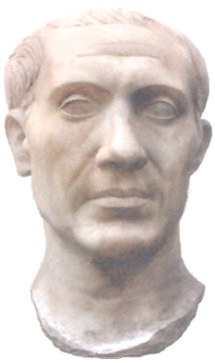...Best of Sicily presents... Best of Sicily Magazine. ... Dedicated to Sicilian art, culture, history, people, places and all things Sicilian. |
by Carlo Trabia | ||
Magazine Index Best of Sicily Arts & Culture Fashion Food & Wine History & Society About Us Travel Faqs Contact Map of Sicily |
While the discovery in some ways confirms Pantelleria's importance as a crossroads of Roman traffic and culture, and also an important trading centre, it raises certain questions about the presence of such works precisely in the locations where they were found. We know that the windy island, known for dessert wines and capers, was historically a place of exile, sometimes for prominent Romans. A controversial cleaning method has left the heads white as freshly fallen snow. (Our photograph of Caesar's head was taken before the restoration.) One may be forgiven for inquiring how, in a place like Sicily, full of archeological wonders, such a discovery elicits excitement among Sicilians as well as visitors. Italian museums, after all, are full of such items. Nowadays, finds of this kind are rare in any part of the former Roman Empire, which at its greatest extent ranged from Scotland across central Germany to Romania to southern Egypt, from Portugal to Persia. Many ancient Sicilian items, whether Phoenician, Greek or Roman, have been exported over the centuries, ending up in private collections or foreign museums. To see these three you'll have to come to Sicily. (Editor's Note: The current exhibit runs through 25 January 2004.) About the Author: Architect Carlo Trabia has written for various magazines and professional journals, as well as this online magazine. | |
Top of Page |
 Recent excavations on the Sicilian island of Pantelleria have yielded
three splendid marble heads of the Roman era. Currently exhibited in the
regional archeological museum in Palermo, the sculptures depict Julius
Caesar (100-44 BC), Titus Flavius Vespesian (AD 39-81) and a
lady believed to be either Agrippina the Elder (14 BC-AD 33) or Antonia
the Younger (36 BC-circa AD 37), mother of Claudius. Julius Caesar (shown here) is the most
readily recognised and most easily identified personage. Discovered in August 2003,
the sculptures were created in granular white marble, that of Titus possibly
Greek stone from Thasos. The head of Julius Caesar, rendered in the Tusculum
style, is almost certainly a posthumous likeness, while that of Titus, though
presenting a youthful image, is typical of those sculpted late in his lifetime,
around AD 79. There is little doubt that the head of Titus was intended
to be part of a statue of his complete body. In Roman times heads were sometimes
sculpted separately from bodies and later attached --actually inserted in
a peg-like construction. The female head is certainly associated with the
Julian dynasty. It has been observed that in Roman times the accurate representation
of actual female personages was rather rare, as most statues were either
"typical" or idealised women or goddesses. This has left us with
little concrete (or marble) knowledge of what certain famous Roman women really looked like.
Recent excavations on the Sicilian island of Pantelleria have yielded
three splendid marble heads of the Roman era. Currently exhibited in the
regional archeological museum in Palermo, the sculptures depict Julius
Caesar (100-44 BC), Titus Flavius Vespesian (AD 39-81) and a
lady believed to be either Agrippina the Elder (14 BC-AD 33) or Antonia
the Younger (36 BC-circa AD 37), mother of Claudius. Julius Caesar (shown here) is the most
readily recognised and most easily identified personage. Discovered in August 2003,
the sculptures were created in granular white marble, that of Titus possibly
Greek stone from Thasos. The head of Julius Caesar, rendered in the Tusculum
style, is almost certainly a posthumous likeness, while that of Titus, though
presenting a youthful image, is typical of those sculpted late in his lifetime,
around AD 79. There is little doubt that the head of Titus was intended
to be part of a statue of his complete body. In Roman times heads were sometimes
sculpted separately from bodies and later attached --actually inserted in
a peg-like construction. The female head is certainly associated with the
Julian dynasty. It has been observed that in Roman times the accurate representation
of actual female personages was rather rare, as most statues were either
"typical" or idealised women or goddesses. This has left us with
little concrete (or marble) knowledge of what certain famous Roman women really looked like.